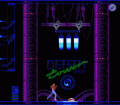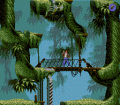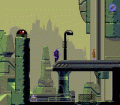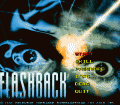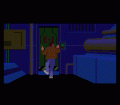Flashback: The Quest for Identity
First posted on 25 December 1999. Last updated on 07 March 2012.
Before 3D games come to prominence, there are the 2D platform games. Essentially, you control a character across a side scrolling map, jumping over platforms which are suspended in midair while collecting power ups and weapon upgrades that are scattered on screen. For years these have been the dominant genre in computer games. In 1992, amidst this popular gaming trend, Delphine Software releases Flashback: The Quest for Identity (also known as Flashback). As I pick up the game and install it, my initial thoughts are that it is pretty much of the same type of games. Gladly, I am wrong.
The game puts you in the shoes of Conrad B Hart, an agent for the Galaxia Bureau of Investigation. During a case, Conrad discovers a sinister plot to take over Earth involving aliens called Morphs who are disguised as government officials. The Morphs kidnap Conrad, wipe his memory, and leave him stranded on a strange alien world. You must help Conrad regain his identity and stop the Morphs' plot to invade Earth at all costs.
Flashback: The Quest for Identity is in essence a game based on the popular platform mold. Built on top of the hand-drawn backgrounds are platforms, doors, walls, buttons, and other elements that Conrad can interact with. Screens after screens of obstacles appear as Conrad makes his way across the levels, which are smoothly interlinked with each another to serve the storyline. The background artworks are some of the best that I have seen in a platform game, though the real innovation comes in the character animation. Conrad runs, jumps, rolls, and falls like a real human. A slip of a step when you suddenly turn him around while running is a nice touch. The realistic movement is credited to the well animated sprites that give Conrad and other game characters a humanlike fluidity. Flashback also departs from the typical scattering of objects and power ups on screen as in most other platform games. In fact, there are no power ups at all, and objects are primarily used to drive the story forward. This adds to the feeling that the plot is to be taken seriously, just like a good sci-fi novel.
The music in the game is sparse and limited to the cinematic sequences during and between levels. For me, the lack of any soundtrack helps to emphasize the bleakness of some of the worlds Conrad is on, though music is much needed for levels like the TV Tower, the prison, and the alien world. Sound effects are also sparse in the game and are limited to gunshots and grunts of people getting hurt. More environmental sounds may have added the extra needed touch.
Flashback: The Quest for Identity is a DOS game and can easily run on today's systems. I find the installation hassle free. If necessary, the game can be run through a Windows DOS session in Windows 95/98. The game is released in both Floppy Disk and CD-ROM versions. Its success on the PC has also triggered adaptations to various game consoles like the Sega Genesis and 3DO systems, the latter of which is essentially the same as the PC version except for some beefed up cinematic sequences. The cinematic sequences on the original Floppy Disk version are flat and comic-like, while those on the enhanced CD-ROM version have fully rendered cut scenes. Delphine Software used a system or engine called Cinematique to develop its games, including this one.
Progression in the game occurs a screen at a time. This gives the game a slower and more intelligent feel, rather than the more action oriented feel that comes when the background moves in conjunction with the character. In most cases, you must study each screen and try to find the least dangerous path across the maze like platforms to the other end. This often involves going back a few screens to press a button or climb up a wall to access an upper portion of the screen you have just visited. Most of the puzzles in the game are of this type, where you must find a way across rooms and platforms to get to an object or a button that triggers something elsewhere. A great example of this is when Conrad is in Titan City needs to finish a number of odd jobs to get all the credits to enroll in the Death Tower show. You first go to the section of the city where the employment office is to pick up a work permit, then to another section to get a job. Using the subway, you travel to different sectors in the city to complete these jobs as they become available, which range from delivering packages to killing pesky mutants.
You move Conrad using the keyboard, which is probably the best method of controlling the character. Controls range from basic moves like running and jumping to a roll that is very useful in getting under low doorways or dodging bullets. Conrad has a sidearm that he picks up early in the game, which has unlimited ammo. The ammo can be upgraded to more powerful ammo on later levels. Other than the sidearm, there are no other weapons that he can pick up. Objects such as the portable shield create a temporary shield around Conrad which is very useful when you are being fired at by multiple enemies. You can also pick up gadgets such as Tele Control, Tele Receiver, and Anti-G belts. However, a particular move which I find perplexing is how Conrad approaches an enemy. Instead of firing his drawn gun which is the logical choice, he swings his arms like windmills. This move does not hurt the enemy but looks very comical.
The game difficulties are divided into easy, medium, and hard. I personally have found that there is little difference between the 3 modes. The game is made up of maps that increase in difficulty. These maps take you through jungles, cities, and 8 alien worlds. Upon the completion of every map, you are given a password that allows you to continue from where you have left off later. Enemies come in many forms, from alien blobs to shapeshifting mutants to cops and many more. There is a challenge in killing each one, and the strategic use of the platforms and walls becomes essential to killing some of them. The game is pretty linear however, as there are no alternates to pathways or solutions to puzzles. The conclusion of the current map always leads to a next one, and so on. It is rumored that the game has a few different endings, though I have not been able to confirm this.
On the upside, the story and gameplay are the definite highlights in this game. Well designed levels are integrated around a solid sci-fi storyline, which is propelled by easy character control and addictive action. Detailed backgrounds and fluid character animations also make this game a joy to look at. On the downside, puzzles requiring Conrad to get from one point to another to press a button or pick up an object can get repetitive, and reloading a game to do something over again and again can become irritating. Solutions to puzzles and maps are also very linear, and the game may have benefited from bonus levels or alternate pathways to the finish point. Since animation is currently limited to your character and enemies, the addition of animated backgrounds may help to add more color to the game. The lack of any soundtrack also detracts from the overall mood of play.
Overall, Flashback: The Quest for Identity is an innovative action/adventure game for its time. It combines the best elements of the platform genre with a good dose of puzzles and a captive storyline. In my opinion, this game is definitely amongst the top 10 platform games of all time.
